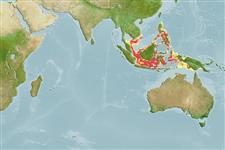>
Eupercaria/misc (Various families in series Eupercaria) >
Labridae (Wrasses) > Cheilininae
Etymology: Cirrhilabrus: Latin, cirrus = curl fringe + Greek, labros = furious (Ref. 45335); brunneus: Name from Latin 'brunneus' meaning dusky or dark, refers to the overall colour pattern of the holotype..
Environment: milieu / climate zone / depth range / distribution range
Ecología
marino asociado a arrecife; rango de profundidad 30 - 60 m (Ref. 90102), usually ? - 40 m (Ref. 75880). Tropical
Western Pacific: Indonesia.
Tamaño / Peso / Age
Maturity: Lm ? range ? - ? cm
Max length : 4.4 cm SL macho / no sexado; (Ref. 75880)
Short description
Morfología | Morfometría
Espinas dorsales (total): 11; Radios blandos dorsales (total): 9; Espinas anales 3; Radios blandos anales: 9. This species is characterized by the following features: D XI, 9; A III, 9; pectoral rays 15; lateral line scales 17 + 6; median predorsal scales 5; horizontal scale rows on cheek below eye 2; gill rakers 13; body depth 3.1 in SL; head length 2.9 in SL; snout length 3.9 in head; males with lunate caudal fin with produced lobes; pelvic fins relatively short, not reaching anal fin origin when depressed; color when alive, males with a dusky brown overall coloration, bronze hue on breast and belly, dark brown median and pelvic fins with broad white posterior margins on dorsal and caudal fins, dorsal and ventral edges of caudal fin with prominent brown margins that taper to a point posteriorly (Ref. 75880).
Sighted in a habitat characterised by a steep slope beginning in relatively deep water; about 10 individuals, including the holotype, were observed at 40 m, on a flat to gently sloping rubble bottom along the upper edge of a vertical drop-off (Ref. 75880).
Life cycle and mating behavior
Madurez | Reproducción | Puesta | Huevos | Fecundidad | Larva
Distinct pairing during breeding (Ref. 205).
Allen, G.R., 2006. Cirrhilabrus brunneus, a new wrasse (Pisces: Labridae) from north-eastern Kalimantan, Indonesia. aqua, J. Ichthyol. Aquat. Biol. 11(1):1-4. (Ref. 75880)
IUCN Red List Status (Ref. 130435)
Threat to humans
Harmless
Human uses
Más información
Age/SizeCrecimientoLength-weightLength-lengthLength-frequenciesMorfometríaMorfologíaLarvaDinámica larvariaReclutamientoAbundanciaBRUVS
ReferenciasAcuiculturaPerfil de acuiculturaRazasGenéticaElectrophoresesheritabilidadEnfermedadesProcesamientoNutrientsMass conversion
ColaboradoresImágenesStamps, Coins Misc.SonidosCiguateraVelocidadTipo de nataciónSuperficie branquialOtolitosCerebrosVisión
Herramientas
Special reports
Download XML
Fuentes de Internet
Estimates based on models
Preferred temperature (Ref.
123201): 27.1 - 28.3, mean 27.8 °C (based on 18 cells).
Phylogenetic diversity index (Ref.
82804): PD
50 = 0.5000 [Uniqueness, from 0.5 = low to 2.0 = high].
Bayesian length-weight: a=0.01585 (0.00707 - 0.03555), b=2.95 (2.76 - 3.14), in cm total length, based on LWR estimates for this (Sub)family-body shape (Ref.
93245).
Nivel trófico (Ref.
69278): 3.2 ±0.4 se; based on size and trophs of closest relatives
Resiliencia (Ref.
120179): Alto, población duplicada en un tiempo mínimo inferior a 15 meses (Preliminary K or Fecundity.).
Fishing Vulnerability (Ref.
59153): Low vulnerability (10 of 100).
